
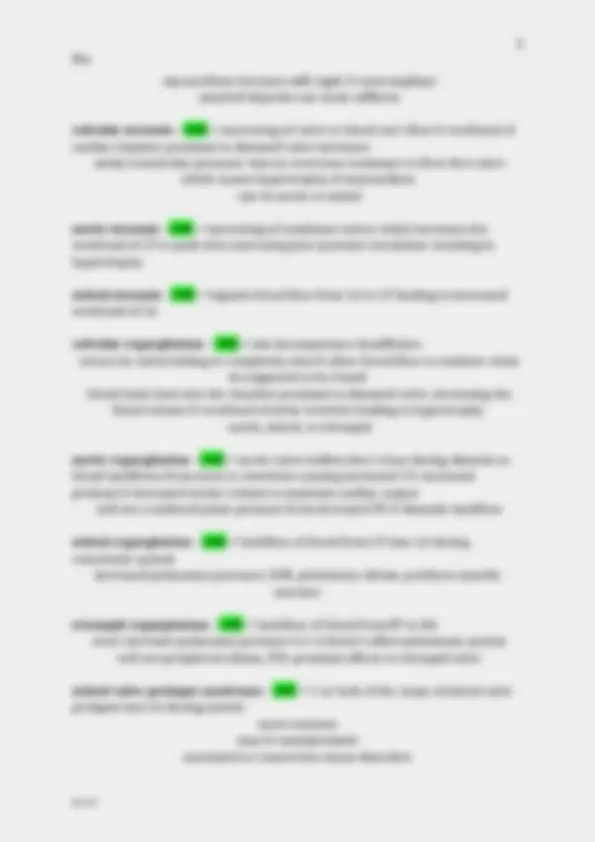
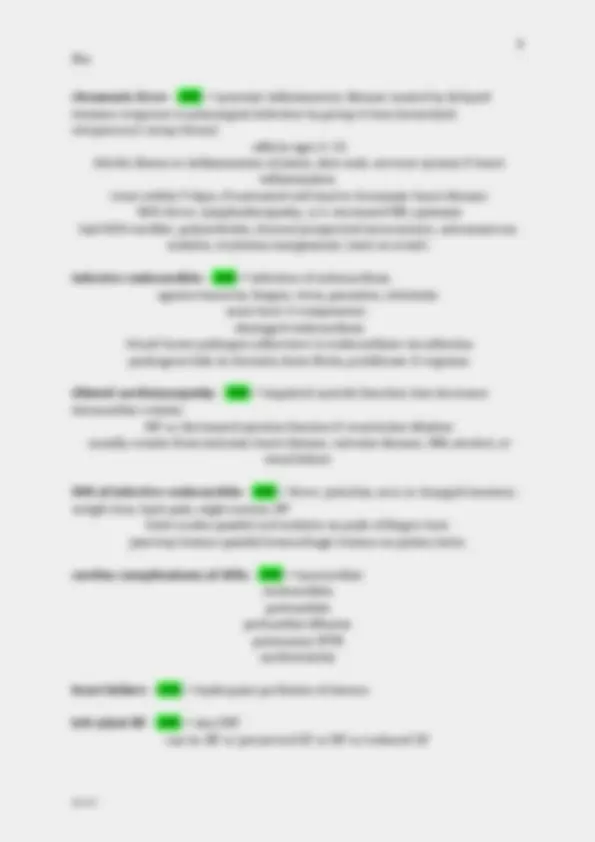

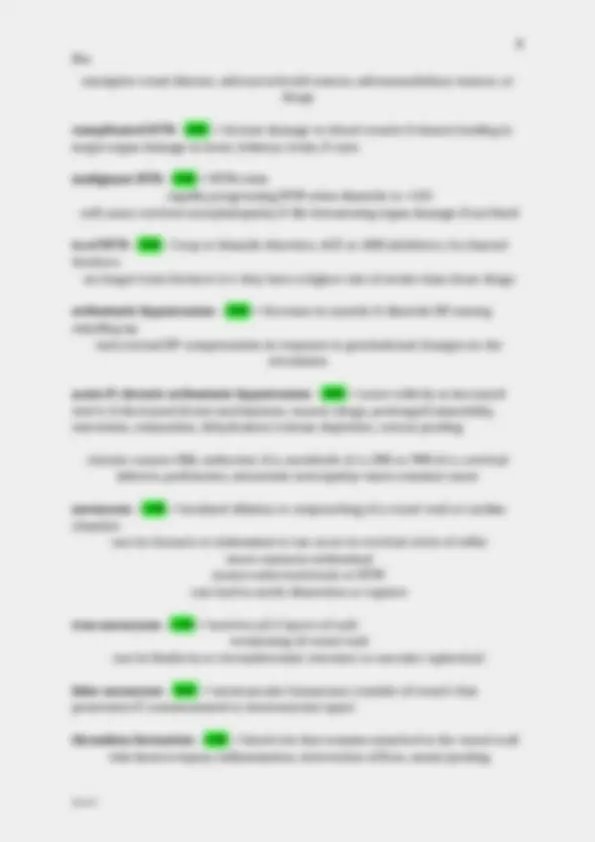
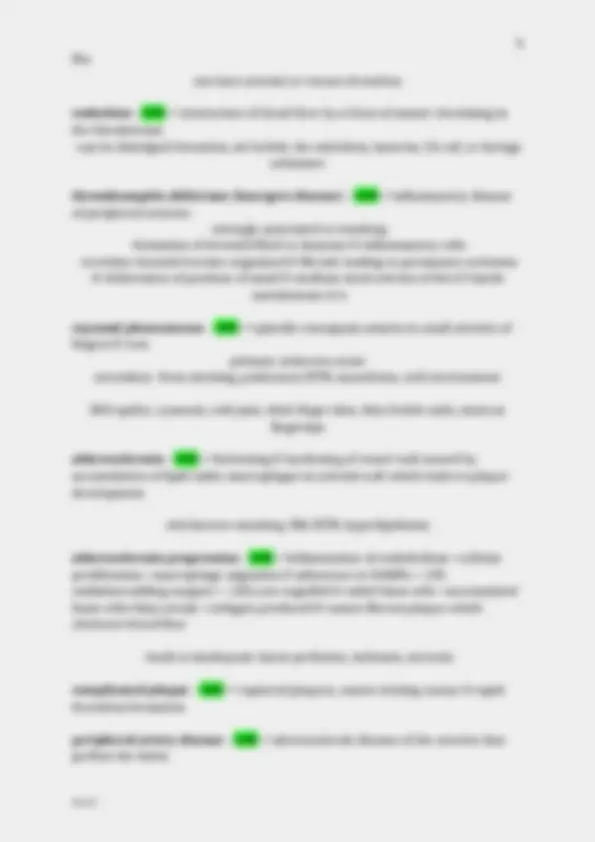
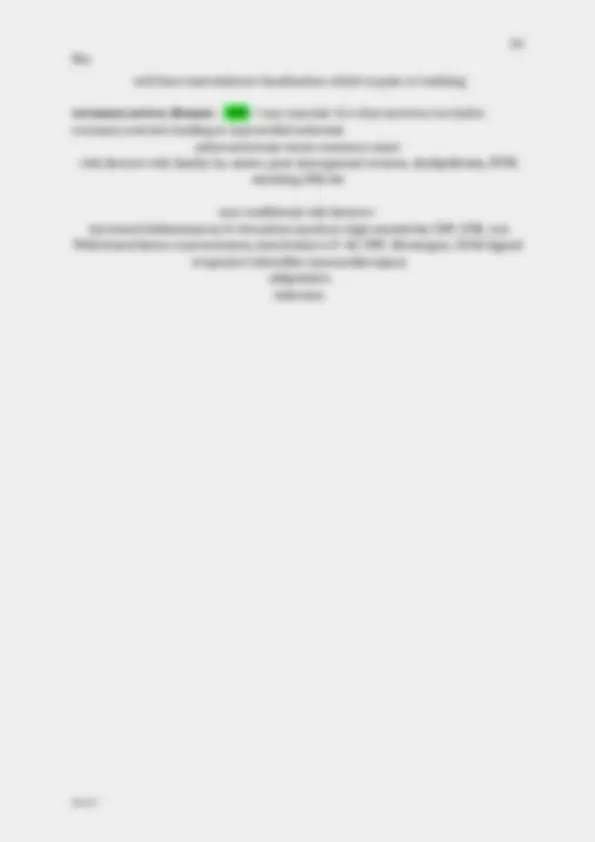


Study with the several resources on Docsity

Earn points by helping other students or get them with a premium plan


Prepare for your exams
Study with the several resources on Docsity

Earn points to download
Earn points by helping other students or get them with a premium plan
Community
Ask the community for help and clear up your study doubts
Discover the best universities in your country according to Docsity users
Free resources
Download our free guides on studying techniques, anxiety management strategies, and thesis advice from Docsity tutors
A comprehensive set of questions and answers covering key concepts related to the cardiovascular system, specifically focusing on myocardial ischemia, acute coronary syndromes, pericarditis, cardiomyopathies, valvular heart diseases, rheumatic fever, infective endocarditis, heart failure, and shock. It is a valuable resource for students studying cardiovascular physiology and pathology.
Typology: Exams
1 / 10

This page cannot be seen from the preview
Don't miss anything!







Bio
myocardial ischemia - ANS ✓local, temporary deprivation of coronary blood supply -need O2 >50% to not decrease function of heart 3 types of myocardial ischemia - ANS ✓stable angina-specific amount of exercise ppl can do before noticing chest pain, chronic, know how far they can go before symptoms start. tx w/NTG to vasodilate -prizmetal angina-occurs unpredictably & at rest, while sleeping. transient ischemia that doesn't follow any pattern -silent iscemia-have ischemia w/out the detectable symptoms like angina acute coronary syndromes - ANS ✓include unstable & stable angina, transient ischemia, sustained ischemia, MI, myocardial inflammation & necrosis unstable angina - ANS ✓results from reversible myocardial ischemia -presents as new onset angina, angina occurring at rest, or angina that increases in severity or frequency -is a sign of impending MI or rupture so will need treated sustained ischemia - ANS ✓can lead to changes in myocardium -stunning the myocytes=ischemia leading to damage of myocardium & makes cells hypocontractible, lasting hours-days (temporary) -hibernating myocardium=myocytes adapt & stop working to prolong their survival, reversible -myocardial remodeling=mediated by RAAS that leads to myocyte hypertrophy & permanent loss of contractile function MI - ANS ✓stemi & nonstemi -nonstemi=affects only the area under endocardium & not thru entire myocardial wall (subendocardail MI) will see ST depression & T wave inversion w/out Q waves
Bio -stemi=affects entire myocardial wall (transmural MI) will see ST elevation, sudden & extended obstruction of myocardial blood supply, leads to death of cells S&S of MI - ANS ✓sudden severe chest pain that may radiate, n/v, diaphoresis, dyspnea, complications=cardiac arrest due to ischemia, L ventricular dysfunction, & electrical instability acute pericarditis - ANS ✓acute inflammation of pericardium -occurs w/anything that increases friction like an increase in proteins, transudate, or anything that causes inflammation of pericardial fluid -leads to friction rubs pericardial effusions - ANS ✓accumulation of fluid in the pericardial cavity -if it occurs slowly over time the pericardium can stretch & accommodate w/out compressing the heart -if it occurs rapidly it causes compression of heart known as cardiac tamponade- which leads to decreased blood flow & can stop it completely constrictive pericarditis - ANS ✓addition of connective tissue that leads to compression of the heart & decreased cardiac output -seen w/TB patients -as you increase metabolic demands the heart can't increase to meet those needs because its restricted -develops gradually hypertropic cardiomyopathy - ANS ✓can be hypertropic obstructive/asymmetrical septal cardiomyopathy OR hypertensive/valvular cardiomyopathy -both increase afterload, decrease EF, & cardiac output hypertropic obstructive cardiomyopathy - ANS ✓thickening of septal wall which causes outflow obstruction of LV tract hypertensive/valvular hypertropic cardiomyopathy - ANS ✓occurs b/c of increased resistance to ventricular ejection, myocytes hypertrophy trying to compensate for increased workload restrictive cardiomyopathy - ANS ✓normal systolic BP but increased diastolic BP & normal wall thickness
Bio rheumatic fever - ANS ✓systemic inflammatory disease caused by delayed immune response to pharyngeal infection by group A beta haemolytic streptococci (strep throat) -affects ages 5- -febrile illness w/inflammation of joints, skin rash, nervous system & heart inflammation -treat within 9 days, if untreated will lead to rheumatic heart disease -S&S=fever, lymphadenopathy, n/v, increased HR, epistaxis bad S&S=carditic, polyarthritis, chorea(unexpected movements), subcutaneous nodules, erythema marginatum (rash on trunk) infective endocarditis - ANS ✓infection of endocardium agents=bacteria, fungus, virus, parasites, rickettsia must have 3 components- -damaged endocardium -blood borne pathogen adherence to endocardium via adhesins -pathogens hide in thrombi, form fibrin, proliferate & vegetate dilated cardiomyopathy - ANS ✓impaired systolic function that increases intracardiac volume -HF w/decreased ejection fraction & ventricular dilation -usually results from ischemic heart disease, valvular disease, DM, alcohol, or renal failure S&S of infective endocarditis - ANS ✓fever, petechia, new or changed murmur, weight loss, back pain, night sweats, HF Osler nodes-painful red nodules on pads of finger/toes janeway lesions-painful hemorrhagic lesions on palms/soles cardiac complications of AIDs - ANS ✓myocarditis endocarditis pericarditis pericardial effusion pulmonary HTN cardiotoxicity heart failure - ANS ✓inadequate perfusion of tissues left sided HF - ANS ✓aka CHF can be HF w/preserved EF or HF w/reduced EF
Bio HF w/reduced EF (HFrEF) - ANS ✓aka systolic HF -inability of heart to generate adequate cardiac output to perfuse tissues EF<40% -decreased contractility, increased preload which will eventually increase afterload & decrease perfusion to tissues -leads to an increase in catecholamines & RAAS to increase BP, CO, & contractility -becomes a vicious positive feedback loop cycle that decreases contractility, increases preload & afterload leading to worsening of L HF HF w/preserved EF (HFpEF) - ANS ✓aka diastolic HF -pulmonary congestion despite a normal stroke volume & cardiac output -results from decreased compliance of LV leading to decreased diastolic relaxation which causes increased preload, backing up into pulmonary circulation & causing pulmonary edema S&S of L HF - ANS ✓pulmonary congestion & inadequate perfusion of systemic circulation SOB, cough w/frothy sputum, fatigue, decreased urine output, edema & pulmonary edema, crackles, pleural effusions, hypo or HTN, S3 gallop drugs to treat HF - ANS ✓+ inotropes=increase contractility diuretics=decrease preload ACE inhibitors/ARBS/aldosterone blockers=decrease preload & afterload R sided HF - ANS ✓inability of RV to produce adequate bloodflow into pulmonary circulation -caused by diffuse hypoxic pulmonary disease -caused by L sided HF that backs up to pulmonary circulation b/c it increases systemic pressure S&S=JVD, peripheral edema, cor pulmonale high output failure - ANS ✓inability of heart to supply body w/blood borne nutrients despite adequate blood volume & normal or increased contractility -the heart will increase its output but body's needs still aren't met -causes= anemia, septicemia, hyperthyroidism, beriberi (vitamin b12 deficiency) shock - ANS ✓cardiovascular system fails to perfuse the tissues adequately resulting in impaired oxygen & glucose use -decreased oxygen & glucose causes cells to use ATP faster than they can make it -increased hydrogen concentration leads to decreased pH & metabolic acidosis occurs
Bio multiple organ dysfunction syndrome - ANS ✓progressive dysfunction of 2 or more organs resulting in an uncontrolled inflammatory response to severe illness/injury -involves stress response, microvascular coagulation, release of cytokines/kinin/inflammatory processes causing decreased blood flow, increased metabolism, decreased perfusion -all organs can be affected varicose veins - ANS ✓vein in which blood has pooled producing distended, tortous, palpable vessels -caused by trauma or gradual vein distention risk factors-female, family hx, fat, pregnant, DVT, prior leg injury chronic venous insufficiency - ANS ✓inadequate venous return over a long period due to varicose veins or valvular incompetence -can lead to venous stasis ulcer thrombus formation - ANS ✓obstruction of venous flow leading to increased venous pressure -3 factors (triad of Virchow) promote thrombosis= 1)venous stasis 2)venous endothelial damage 3)hypercoagulable states -usually occurs in lower extremities & is asymptomatic superior vena cava syndrome - ANS ✓progressive occlusion of SVC that leads to venous distention in upper extremities & head -causes=tumors of lymphatics or bronchus -a low pressure vessel HTN - ANS ✓consistent elevation of systemic arterial BP -systolic > -diastolic > 90 primary HTN - ANS ✓most common, aka essential or idiopathic -genetic & environmental factors -SNS causes increased HR & vasoconstriction which increase BP -overactive RAAS causes Na & water retention, increased vascular resistance, insulin resistance & platelet aggregation -decreased renal excretion of salt=pressure-natriuresis relationship secondary HTN - ANS ✓caused my systemic disease process that raises peripheral vascular resistance or cardiac output
Bio examples=renal disease, adrenocorticoid tumors, adrenamedullary tumors, or drugs complicated HTN - ANS ✓chronic damage to blood vessels & tissues leading to target organ damage in heart, kidneys, brain, & eyes malignant HTN - ANS ✓HTN crisis -rapidly progressing HTN when diastolic is > -will cause cerebral encephalopathy & life threatening organ damage if not fixed tx of HTN - ANS ✓loop or thiazide diuretics, ACE or ARB inhibitors, Ca channel blockers -no longer beta blockers b/c they have a higher rate of stroke than those drugs orthostatic hypotension - ANS ✓decrease in systolic & diastolic BP among standing up -lack normal BP compensation in response to gravitational changes on the circulation acute & chronic orthostatic hypotension - ANS ✓acute=elderly at increased risk b/d decreased thrust mechanisms. causes=drugs, prolonged immobility, starvation, exhaustion, dehydration/volume depletion, venous pooling chronic-causes=DM, endocrine d/o, metabolic d/o, CNS or PNS d/o, cerebral infarcts, parkinsons, autonomic neuropathy=most common cause aneurysm - ANS ✓localized dilation or outpouching of a vessel wall or cardiac chamber -can be thoracic or abdominal or can occur in cerebral circle of willis -most common=abdominal causes=atherosclerosis or HTN -can lead to aortic dissection or rupture true aneurysm - ANS ✓involves all 3 layers of wall -weakening of vessel wall -can be fisuform or circumferential (circular) or saccular (spherical) false aneurysm - ANS ✓extravascular hematoma (outside of vessel) that penetrates & communicated w/intravascular space thrombus formation - ANS ✓blood clot that remains attached to the vessel wall -risk factors=injury/inflammation, obstruction of flow, stasis/pooling
Bio -will have intermittent claudication which is pain w/walking coronary artery disease - ANS ✓any vascular d/o that narrows/occludes coronary arteries leading to myocardial ischemia atherosclerosis=most common cause -risk factors=old, family hx, males, post menopausal women, dyslipidemia, HTN, smoking, DM, fat non-traditional risk factors= -increased inflammatory & thrombus markers-high sensitivity CRP, ESR, von Willebrand factor concentration, interleukin 6 & 18, TNF, fibrinogen, CD40 ligand -troponin I-identifies myocardial injury -adipokines -infection